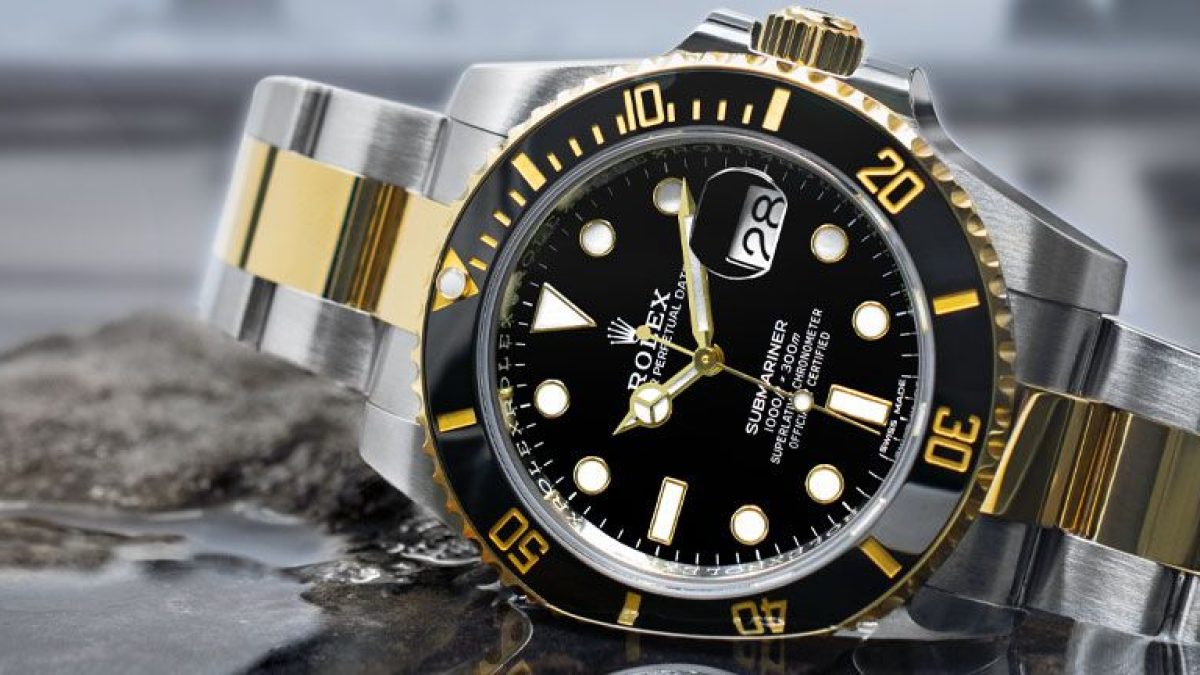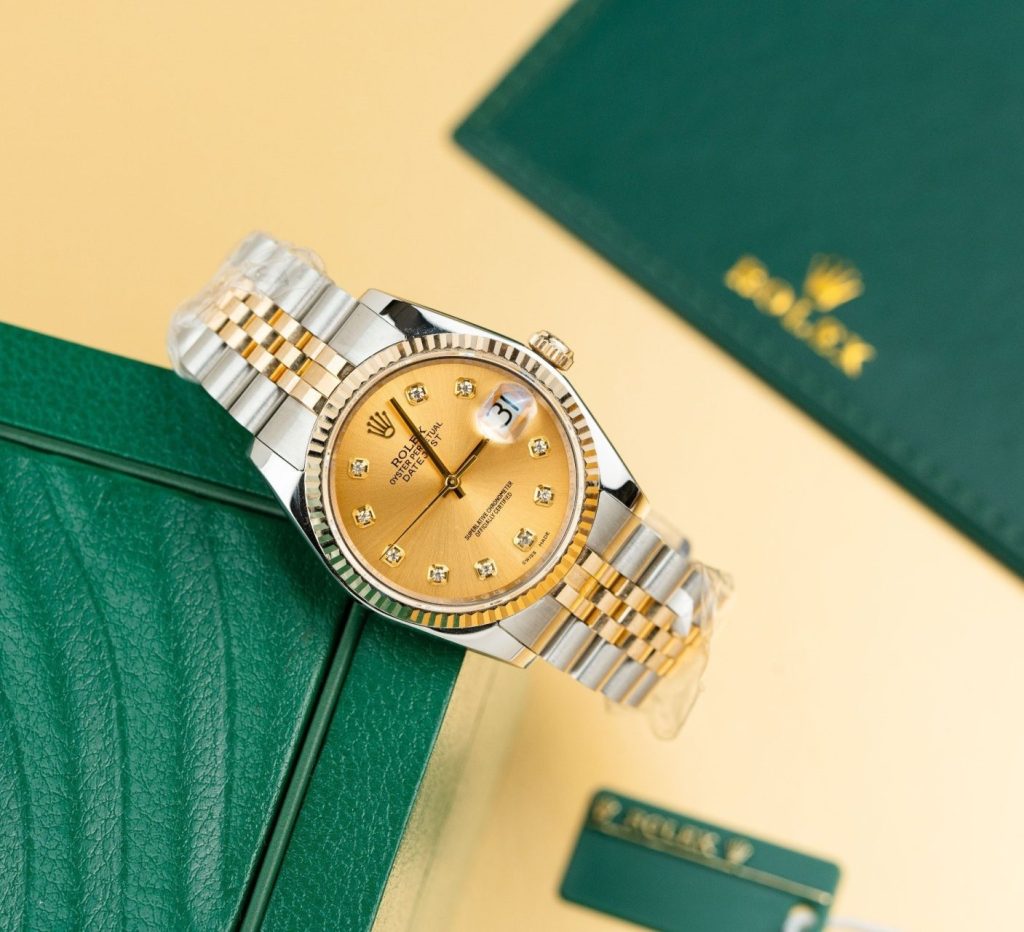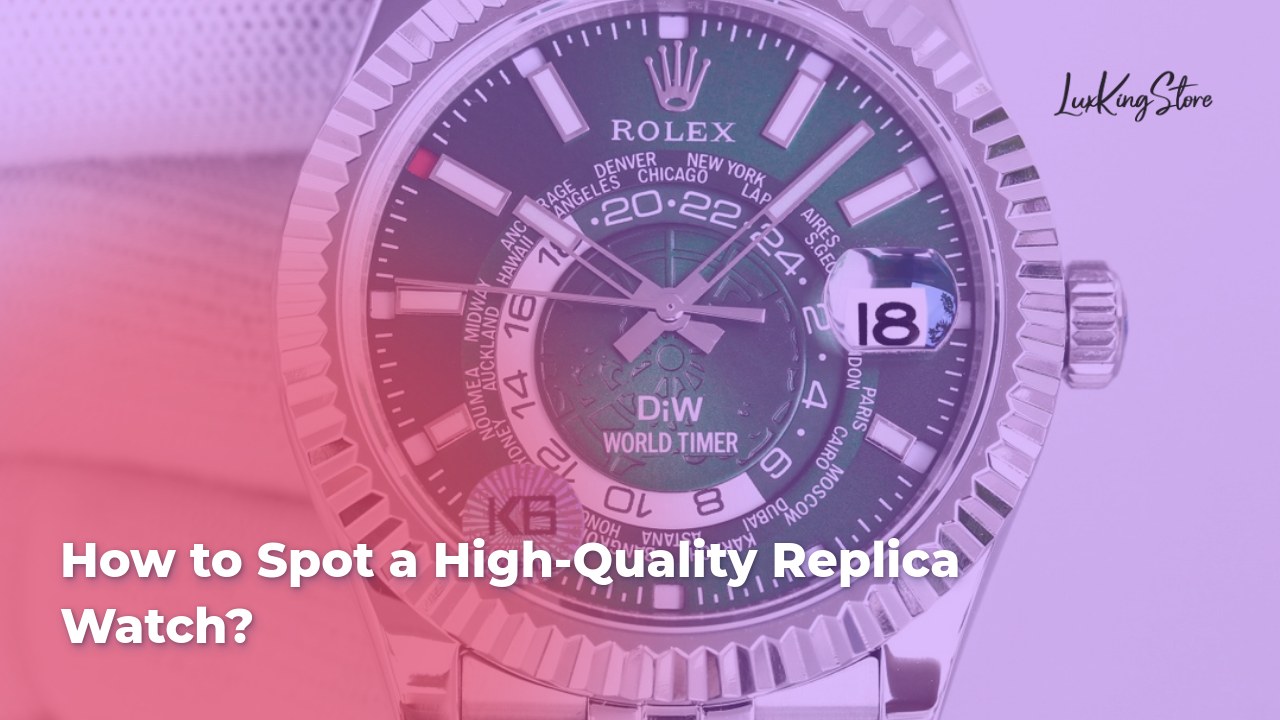How to Spot a High-Quality Replica Watch?
How to Spot a High-Quality Replica Watch?
In the world of luxury timepieces, the allure of high-end brands like Rolex, Omega, and Audemars Piguet often attracts more than just legitimate buyers. Many individuals find themselves tempted by high-quality replica watches that promise a similar look at a fraction of the price. However, while some replicas may closely mimic their authentic counterparts, distinguishing between a high-quality replica and a genuine timepiece requires careful examination. Is it possible to achieve a similar aesthetic without draining your savings? How to Spot a High-Quality Replica Watch – Essential Guide – Understanding how to identify high-quality replicas empowers you to make informed choices without compromising on style or integrity.
This comprehensive guide delves into the intricacies of spotting high-quality replica watches. You’ll learn about the key characteristics that set these replicas apart from lower-quality imitations and genuine models. We’ll explore various factors, such as materials, craftsmanship, and movement, that contribute to a watch’s overall quality. Whether you’re a seasoned collector or a first-time buyer, our insights into examining your next potential purchase will prepare you to not only identify but also appreciate the nuances of high-quality replicas.
Key Characteristics of High-Quality Replica Watches
To effectively spot a high-quality replica watch, one must pay close attention to several essential characteristics. Often, these distinguishing features can be the deciding factor between a wise purchase and an unfortunate mistake. Below are some crucial elements to consider:
- Materials: The foundation of any quality timepiece lies in its materials. High-quality replicas often employ stainless steel and other premium materials that closely resemble those used in genuine watches. For instance, while authentic luxury watches might utilize 904L stainless steel or specialized alloys, a high-grade replica will aim for similar durability with standard stainless steel. Moreover, watch crystals should be made of sapphire rather than plastic, which can easily scratch or shatter.
- Craftsmanship: The finesse and attention to detail in craftsmanship are critical indicators of a high-quality replica. Look for precision in the symmetry of the watch case and the watch face. Genuine luxury watches are handcrafted with meticulous detailing that can be hard to replicate accurately. Pay attention to features such as sharp edges, clean joints, and even the watch’s overall finishing. A well-crafted replica will exhibit near-perfect symmetry and smooth surfaces, while lower-end models may reveal rough edges or uneven finishes.
- Weight and Feel: When considering the weight of a watch, remember that high-quality replicas should mirror the heft of their genuine counterparts. Authentic luxury watches are typically heavier due to the use of superior materials. A light fake can signal inferior construction or an inadequate material selection. Hold the watch and gauge its weight; if something feels off, it likely is.
- Movement Quality: The heart of any watch, the movement determines its functionality and precision. A reputable replica watch may utilize a movement that closely mimics the Swiss mechanical or automatic systems. For example, an imitation of a Rolex Submariner should ideally have a sweeping second-hand motion rather than a jerky ticking an indication of a quartz movement. Assessing the movement is perhaps one of the most daunting yet vital tasks in distinguishing quality.
- Unique Features: Lastly, pay attention to the unique features that define the authenticity of the piece. High-quality replicas strive to imitate signature elements such as engravings, cyclops lenses, or specific dial marks. These features are instrumental in reflecting the watch’s brand, and any discrepancies may denote a low-quality imitation. Authentic luxury watches usually incorporate complex functionalities that can be difficult to replicate convincingly.

Differences Between Genuine and Replica Watches
Distinguishing between genuine and replica watches requires an understanding of the key differences often present in their design and functionality. Authentic timepieces, particularly in the luxury market, maintain a level of craftsmanship and technology that is notoriously difficult for replicas to match. Here are the core differences:
- Authenticity Verification: Genuine watches typically have unique serial numbers that can be validated through the manufacturer’s database. Replica watches may either lack these numbers or feature poorly engraved copies that are hard to trace. A thorough authenticity check can help prospective buyers confirm the legitimacy of their purchase.
- Brand Quality: Luxury brands invest significant resources in research, development, and quality control. For instance, Rolex utilizes premium-grade materials like 904L stainless steel and features that withstand not only time but also physical exploration. Replicas, however, may cut corners, using inferior materials that compromise longevity and resilience.
| Feature | Genuine Watches | High-Quality Replicas |
|---|---|---|
| Material Quality | 904L Stainless Steel | Standard Stainless Steel |
| Movement | Swiss Mechanical | Mimics Swiss, often quartz-based |
| Authenticity Documentation | Includes Valid Serial Numbers | Often Lacks Authentic Verification |
| Weight | Heavier due to Better Materials | Can be lighter, indicating inferior construction |
- Functionality: Authentic luxury watches implement advanced technology that ensures precise timekeeping and added features. For instance, a genuine Omega Seamaster would boast a chronometer certification dose of precision, while replicas often lack these technical attributes and can run erratically over time.
- Price Difference: While the price of genuine luxury watches can be exorbitant often exceeding thousands or even tens of thousands of dollars high-quality replicas aim for affordability. While some replicas may reach hundreds of dollars, the difference significantly favors authenticity in terms of value retention.
- Packaging and Accessories: Lastly, packaging plays an essential role in brand representation. Genuine luxury watches are typically accompanied by high-end packaging complete with authentication cards, user manuals, and warranty documents. In contrast, high-quality replicas may come in generic or plain boxes, lacking the finesse that defines luxury.
Common Indicators of Low-Quality Replicas
Recognizing the markers of low-quality replicas is vital to making an informed purchase in the luxury watch market. Buyers should remain vigilant by examining the following indicators to avoid a regrettable transaction:
- Use of Inferior Materials: One of the first red flags for a replica is its material composition. Low-quality fakes often use lightweight metals or plastic for the watch case and bracelet, resulting in a flimsy construction that lacks the durability of genuine luxury watches. For instance, cheap replicas may feature mineral glass, which scratches easily, rather than the robust sapphire crystal standard in authentic timepieces.
- Craftsmanship Flaws: Here, attention to detail becomes paramount. Low-quality replicas typically exhibit rough edges, uneven constructions, or poorly executed engravings. Key identifiers include misaligned logos, spelling errors, or faded lettering that signify a lack of care in manufacturing. For instance, an authentic TAG Heuer will have meticulously aligned text on the dial which is hardly replicated accurately in inferior models.
- Movement Performance: The movement quality is another vital indicator when assessing replica watches. Lower-end models usually contain basic quartz movements that produce a jerky ticking motion, in contrast to the smooth sweeping motion of a genuine Swiss mechanism.
- Lack of Weight: A significant warning sign in identifying low-quality replicas is the overall weight of the watch. Because these lower-tier replicas often compromise on materials, they tend to feel noticeably lighter than authentic pieces, raising suspicions regarding their quality.
| Indicator | Low-Quality Replicas | High-Quality Replicas |
|---|---|---|
| Materials | Lightweight Plastic | High-Grade Stainless Steel |
| Craftsmanship | Poorly Aligned Text | Neat, Well-Defined Details |
| Movement | Tick-Tock Motion | Smooth Sweep |
| Overall Weight | Light | Substantial Heft |
- Packaging: Lastly, the overall presentation can hint at manufacturing quality. Low-quality replicas typically come in cheap packaging that lacks proper branding, while reputable replicas aim for a higher standard. Authentic watches, on the other hand, usually come in lavish boxes alongside necessary documentation and authentication materials.
Materials Used in High-Quality Replicas
Examining the materials utilized in high-quality replicas is essential for discerning their overall authenticity and quality. By understanding what materials signify quality, buyers can make more informed choices:
- Stainless Steel: High-quality replicas frequently utilize stainless steel, as it resembles the composition of authentic luxury timepieces. However, details such as surface finishing and the alloy quality can indicate a replica’s authenticity. For instance, while lesser replicas might use a thinner grade, high-quality replicas are often crafted from heavier, more durable stainless steel.
- Sapphire Crystal vs. Mineral Glass: Authentic luxury watches, known for their resistance to scratches, typically utilize sapphire crystals. High-quality replicas try to mimic this by using synthetic sapphire glass that closely resembles the durability and clarity of the original. Recognizing the subtle variations in light reflection can often reveal the presence of cheaper glass in lower-quality replicas.
- Leather and Fabrics: Premium quality leather straps can elevate the overall appearance of a watch. High-quality replicas usually incorporate leather of similar quality to the genuine counterparts, featuring consistent stitching and finely detailed textures. In contrast, low-quality models may utilize synthetic or faux materials that can show signs of wear rapidly.
| Material | High-Quality Replica | Low-Quality Replica |
|---|---|---|
| Case Material | Heavy-duty Stainless Steel | Lightweight Alloy or Plastic |
| Watch Glass | Synthetic Sapphire | Mineral Glass |
| Strap Material | Genuine Leather or Quality Fabric | Cheap Synthetic Material |
- Finishing Processes: The polishing and finishing processes in high-quality replicas generally mimic the aesthetics used in luxury brands. Genuine luxury watches would typically exhibit a brushed finish that enhances their sophistication. In contrast, lower-quality replicas often demonstrate poorly applied finishes, leading to unsightly flaws.
- Functional Features: High-quality replicas may implement similar functionalities, such as water resistance or chronograph features. Understanding how these functions operate in genuine models can assist buyers in determining whether the replica accurately imitates the original’s trademark technologies.
Importance of Watch Movement in Replicas
When determining the quality of a replica watch, the movement, or mechanism that powers the watch, emerges as a crucial aspect. The type of movement used can significantly influence both performance and longevity:
- Types of Movements:
- Automatic Movements: These movements wind themselves through the motion of the wearer’s wrist, often found in high-end replicas and genuine luxury watches alike. They are characterized by their complexity and provide a seamless sweeping motion of the second hand.
- Manual Movements: Users need to wind these movements manually. While they are less common in modern watches, high-quality replicas may incorporate them, showcasing craftsmanship.
- Quartz Movements: Usually cheaper and more widespread, quartz movements typically offer less precision and create that noticeable ticking motion. Many low-quality replicas employ these movements to cut costs.
| Movement Type | High-Quality Replicas | Low-Quality Replicas |
|---|---|---|
| Automatic | Mimics Genuine Mechanisms | Often uses Cheap Quartz |
| Accuracy | High-Level Precision | Moderate to Low Accuracy |
| Sweeping Second Hand | Fluid Motion | Tick-Tock Motion |
- Accuracy and Reliability: High-quality replicas generally prioritize incorporating movements that offer a greater degree of accuracy and reliability. Understanding the intricacies of the movement can help buyers distinguish higher-tier replicas from mere fakes.
- Calibration and Service: Like their genuine counterparts, high-quality replicas may require occasional servicing to maintain accuracy. This is particularly true for automatic movements, which need to be thoroughly lubricated and tested for precision over time.
- Mechanics and Craftsmanship: A genuine luxury watch’s mechanics can involve upwards of 100 finely-tuned components working harmoniously. While replicating this complexity poses a challenge for manufacturers of high-grade replicas, advanced designs strive to mimic these intricacies closely.
- Consumer Experience: Lastly, for purchasers looking to enjoy the experience of handling a luxury watch, observing the movement is crucial. Smooth motion, coupled with elegant interactions with the crown or chronograph, can significantly enhance the user’s engagement with the product.

Examining the Watch Finish and Detailing
One of the more telling aspects when evaluating a replica watch lies in its finish and detailing. The appearance of a timepiece often constitutes its initial appeal. High-quality replicas aim to replicate the fine finish standards set by luxury brands:
- Craftsmanship in Finishing: High-end replicas often display a high degree of attention to finishing, exhibiting immaculate surfaces and consistently applied polishing. In contrast, low-quality replicas may reveal fingerprints, rough edges, or inconsistency in finishes that betray their lack of quality.
- Etchings and Engravings: The precision of engravings on a watch can also speak volumes about its quality. Genuine luxury watches feature intricate logos and markings with sharp details, while low-quality replicas often show signs of poor workmanship, including blurry letters or misplaced logos.
- Dial and Hands Detailing: The clarity of the dial and the hand designs represent vital components of a watch. High-quality replicas replicate these aspects closely, maintaining balance in the proportions of each element. Misalignment or poor finishing around the hands could indicate an inferior replica.
| Detail Aspect | High-Quality Replica | Low-Quality Replica |
|---|---|---|
| Edge Smoothness | Impeccably Polished | Rough Edges |
| Engravings | Crisp, Clear Marks | Fuzzy, Inconsistent |
| Dial Clarity | Well-Defined Elements | Blurred Textures |
- Surface Reflections: When you engage with a luxury watch, notice how light plays across its surfaces. A genuine watch’s finish will reflect light in a sophisticated manner, while low-quality imitations may appear dull or uneven.
- Attention to Detail: Finally, the overall attention to detail in crafting the small features, such as crown engravings, case back etchings, and even markers on the watch face, significantly contributes to the overall aesthetic. Replicas that capture these nuances will generally stand out against their less competent counterparts.
Recognizing Authentic Branding and Logos
When it comes to identifying high-quality replicas, recognizing authentic branding and logos can be instrumental. Luxury brands, renowned for their precise designs and unique logos, often implement several telltale indicators in their products:
- Logo Placement: Authentic luxury watches have specific guidelines regarding the placement of their logos. For instance, the positioning of the Rolex crown at 12 o’clock is distinct and well known. Any deviations in placement might indicate a replica.
- Quality of Branding: Authentic logos are usually produced with high clarity that reflects premium craftsmanship. Look for any irregularities in spacing, font variations, or symbol inaccuracies in replicas, as they reveal inferior production quality.
- Distinct Patterns and Embossments: Many luxury brands incorporate unique patterns into the finishing touches of their watches these are hard to replicate accurately. For example, Omega employs proprietary patterns known throughout their line of watches. Pay attention to the patterns on the dial, case back, and even watch straps.
| Branding Aspect | High-Quality Replica | Low-Quality Replica |
|---|---|---|
| Logo Clarity | Sharp, Well-Aligned | Blurry, Misaligned |
| Embossing Quality | Precise, Detailed | Subpar, Generic |
| Specific Patterns | Accurate Replication | Poor Imitation |
- Documentation Checks: High-quality replicas should ideally come with some form of authentication or documentation. Authentic luxury watches provide certificates and cards proving their credentials along with packaging. If a watch lacks this aspect, it raises red flags.
- Reputation of the Brand: Familiarize yourself with the manufacturing specifics of your favorite watch brands. Using this knowledge can greatly aid in spotting fakes, as you’ll be better equipped to identify discrepancies in design or specifications.
Where to Buy High-Quality Replica Watches
Finding a trustworthy source for high-quality replicas is critical. Navigating the market can be challenging, but knowing where to look can help ensure you receive a premium product without falling into counterfeit traps:
- Reputable Online Retailers: Several established online retailers focus on supplying high-quality replicas from respected manufacturers. Look for websites with positive reviews, comprehensive return policies, and verification of what they offer. Sites with user-generated content often give a clearer picture of buyer experiences.
- Linked Forums and Communities: Engaging in watch enthusiast forums can be a fantastic resource for recommendations. Members frequently share their experiences regarding reputable retailers or even connect with reliable sellers directly.
- Trusted Local Dealers: If you prefer to examine products in person, seek out local watch dealers who specialize in replicas. Ensure they offer guarantees and solid return policies, providing a level of confidence in your transaction.
- Social Media Outreach: Social platforms such as Instagram or Facebook can also provide insights into reputable brands selling high-quality replicas. Check pages dedicated to watch reviews and buyers’ feedback to foster knowledge about what you are purchasing.
| Buying Option | Pros | Cons |
|---|---|---|
| Reputable Online Retailers | Wide Selection, Convenience | Risk of Misrepresentation |
| Watch Forums | Community Support, Expert Guidance | Varies by Individual Experience |
| Local Dealers | Hands-on Inspection, Immediate Purchase | Limited Availability |
| Social Media | Fresh Insights, Trends | Potentially Unverified Sources |
- Be Cautious of Appealing Prices: Extremely low prices can often signal counterfeit or poor-quality products. Always research the typical pricing for high-quality replicas to recognize substantially low offers as red flags.

Maintenance Tips for High-Quality Replicas
Maintaining the quality of your high-quality replica watch not only contributes to its aesthetic longevity but can also preserve its functionality over time. Here are some essential maintenance tips to uphold your timepiece in good condition:
- Regular Cleaning: Regular cleaning is crucial for maintaining the appearance and integrity of your watch. Use a soft, lint-free cloth to gently wipe down the case and strap, removing dust or moisture. For thorough cleaning, use mild soap diluted in water and a soft brush but ensure not to submerge the watch unless it is specifically water-resistant.
- Check Water Resistance: If your replica watch is rated for water resistance, verify that it retains this feature. Over time, gaskets can degrade, allowing moisture to enter. Have these seals inspected and replaced by a professional to avoid damage.
- Movement Lubrication: Just like genuine watches, high-quality replicas benefit from occasional movement lubrication. If you notice inaccuracies or unusual sounds, have it serviced to prevent potential internal wear that could lead to more significant problems down the line.
| Maintenance Aspect | Frequency | Method |
|---|---|---|
| External Cleaning | Monthly | Soft Cloth, Mild Soap |
| Water Resistance Check | Annually or as Needed | Professional Assessment |
| Movement Care | Every 3-5 Years | Expert Servicing |
- Battery Management for Quartz Models: If your replica watch operates on a quartz movement, remain vigilant about changing the battery. Do this promptly to prevent potential leakage that could damage the internal mechanisms. Have this service performed by a certified technician to ensure correct handling.
- Inspecting for Wear: Regularly inspect your watch for any signs of wear or damage, such as loosening links in the bracelet or scratches on the glass. Noticing small issues early can prevent extensive repairs and preserve the quality of the piece.
Frequently Asked Questions (FAQs)
- What is a high-quality replica watch?
A high-quality replica watch closely mimics the appearance and functionality of genuine luxury timepieces, employing premium materials and craftsmanship. - How can I check if a watch is a replica?
Assess its materials, movement, weight, and finish. Look for discrepancies in logos, engravings, and serial numbers to help identify authenticity. - Are high-quality replicas worth it?
High-quality replicas can offer excellent value for individuals looking for aesthetic appeal without the high costs of genuine watches, provided they’re sourced from reputable sellers. - Can I maintain a replica watch like a genuine watch?
Yes, high-quality replicas deserve similar maintenance to ensure their longevity, including regular cleaning, movement care, and checking for water resistance. - Where is the best place to buy a high-quality replica watch?
Reputable online retailers, watch enthusiast forums, and trusted local dealers are great sources for high-quality replicas, but always exercise caution and due diligence.
Key Takeaways
- Distinguishing high-quality replica watches involves examining materials, craftsmanship, and movement.
- Genuine watches are characterized by specific features, engravings, and serial numbers.
- Low-quality replicas often reveal themselves through poor craftsmanship and lightweight materials.
- Knowledge of where to purchase replicas and how to maintain them is essential for long-term satisfaction.
- Regular inspections and care can significantly enhance the lifespan of a high-quality replica watch.
Conclusion
Spotting a high-quality replica watch requires attentive observation and knowledge of the distinguishing traits that set superior replicas apart from their lesser counterparts. Understanding the nuances of materials, craftsmanship, movement, and branding empowers buyers to make informed choices, enhancing their shopping experience and satisfaction with their purchases. Whether you are drawn to a replica for aesthetic appeal, budget constraints, or a combination of both, knowing how to identify quality ensures that you embrace smart spending without sacrificing style. With proper maintenance, a high-quality replica watch can serve as a reliable companion, offering both functionality and elegance for years to come.
Google Search Keywords:
- high-quality replica watches
- how to identify fake watches
- luxury replica watch buying guide
- best materials for replica watches
- maintenance tips for replica watches
You Can See More Product: How to Spot a High-Quality Replica Watch

